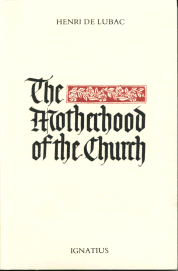 From Ignatius Insight Scoop - Pontifications has posted a lengthy excerpt, "Petrine Office and Particular Churches," penned by Henri de Lubac, S.J. (see author page) It seemed familiar and I finally figured out why — it is part of a longer piece, "The Center of Unity," which is a chapter in de Lubac's outstanding book, The Motherhood of the Church. Anyhow, de Lubac writes:
From Ignatius Insight Scoop - Pontifications has posted a lengthy excerpt, "Petrine Office and Particular Churches," penned by Henri de Lubac, S.J. (see author page) It seemed familiar and I finally figured out why — it is part of a longer piece, "The Center of Unity," which is a chapter in de Lubac's outstanding book, The Motherhood of the Church. Anyhow, de Lubac writes:There has never been a Christianity without Church, and there has never been a universal Church without particular churches. Wherever the Eucharist is celebrated, the Catholic Church is present whole and undivided. The bishop of the most insignificant market town is in this respect, as St Jerome observes, the equal of the bishop of Rome.
But there were never any autonomous particular churches which then joined together in a federation to form a universal church, any more than the twelve disciples chosen by Jesus subsequently came together on their own initiative. In its multiple realizations the Church is fundamentally one. In the multiplicity of its members, the college of bishops is fundamentally one. These truths have often been reiterated. Since the last Council in particular they have been the subject of a series of excellent expositions. Consequently I have no intention of lingering over them.
I want simply, first of all, to clarify a few points regarding the idea of collegiality, which seems to me rather important, and on its possible relation to the idea of bishops’ conferences. Next, I want to emphasize the role of the successor of St Peter as bond of the college of bishops and center of Catholic unity, as it follows from the Gospel. In conclusion, we shall examine some new tendencies or suggestions on this point. (Read rest of the excerpt here.)

No comments:
Post a Comment